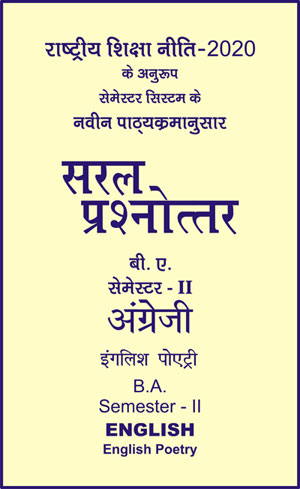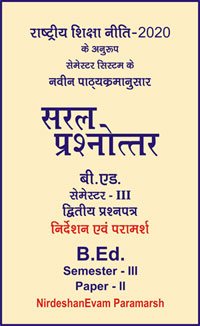|
बी ए - एम ए >> बीए सेमेस्टर-2 - अंग्रेजी - इंगलिश पोएट्री बीए सेमेस्टर-2 - अंग्रेजी - इंगलिश पोएट्रीसरल प्रश्नोत्तर समूह
|
|
|||||||
बीए सेमेस्टर-2 - अंग्रेजी - इंगलिश पोएट्री
Objective Type Questions
For each of the following questions, four alternatives are given for the answer: Only one of them is correct. Choose the correct alternative.
1. In which year was Thomas Gray born?
(a) 1716
(b) 1717
(c) 1718
(d) 1719
2. What was the name of the churchyard where Gray was buried?
(a) New Place
(b) Startford
(c) Stoke Poges
(d) None of these.
3. Who was the close friend of Gray?
(a) Robert Browning
(b) Tennyson
(c) Matthew Arnold
(d) Horace Walpole.
4. In which year was Gray appointed professor at Cambridge?
(a) 1765
(b) 1768
(c) 1770
(d) 1775
5. The diction of Gray is -
(a) artificial and ornate
(b) impressive
(c) dignified
(d) simple
6. What did Gray refuse?
(a) Money
(b) Ph. D. Degree
(c) The Poet Laureateship
(d) Land
7. Gray was the ....... of the romantic lovers of Nature.
(a) first
(b) second
(c) third
(d) fourth
8. It is said, "Gray was romantic in spirit and classical in manner." Is it true?
(a) No
(b) Yes
(c) Don't know
(d) None of these
9. Thomas Gray was a -
(a) optimist
(b) reformer
(c) dramatist
(d) pessimist
10. Gray is not a pure classicist but a ....... poet.
(a) Elizabethan
(b) Transitional
(c) Victorian
(d) None of these
11. Gray's poetry glides from classicism to ........
(a) romanticism
(b) supernaturalism
(c) modernism
(d) None of these
12. 'The Bard' is ..........
(a) sonnet
(b) elegy
(c) lyric
(d) ode
13. "The Bard' expresses the sentiments of the .........
(a) lover
(b) friend
(c) bard
(d) sailor
14. Gray's 'An Elegy Written in a Country Churchyard' is a ........ elegy.
(a) general
(b) personal
(c) common
(d) None of these.
15. Where does the poet stand?
(a) Window
(b) Church
(c) Library
(d) Churchyard
16. 'An Elegy Written in a Country Churchyard' begins with the .........
(a) Thunder
(b) Rain
(c) Ringing of the curfew
(d) Announcement of the curfew.
17. The atmosphere around the poet is
(a) pleasant
(b) gloomy
(c) graceful
(d) None of these
18. 'An Elegy Written in a Country Churchyard' was published in ........
(a) 1751
(b) 1752
(c) 1753
(d) 1754
19. 'An Elegy Written in a Country Churchyard' is a poem in mourning for ........ the entire
(a) town
(b) village
(c) country
(d) humanity
20. 'An Elegy Written in a Country Churchyard' is not ........ poem.
(a) an escape
(b) a gloomy
(c) a sad
(d) None of these
21. 'An Elegy Written in a Country Churchyard' is cry for .........
(a) deep love
(b) reformation
(c) human sympathy
(d) None of these
22. Gray reflects on the........ of the poor villagers that lie before him.
(a) homes
(b) fields
(c) cattles
(d) graves
23. Will any sound make the dead villagers awake?
(a) Always
(b) Never
(c) Sometimes
(d) None of these
24. "The paths of glory lead but to the ......
(a) grave
(b) home
(c) palace
(d) court
25. The rich and the poor all ......
(a) happy
(b) sad
(c) die
(d) hungry
26. What are written on the stone on the graves of the poor villagers?
(a) Only their names and dates of birth
(b) Their whole details
(c) Their address
(c) None of these
27. Where is the ploughman going?
(a) To the field
(b) To the forest
(c) To the river
(d) To the home
28. What does the poet call 'the grave'?
(a) Hut
(b) Room
(c) Narrow cell
(d) Palace
29. For whom shall no hearth be burnt?
(a) Dead villagers
(b) Farmers
(c) Friends
(d) Enemies
30. What, according to Gray, is 'neglected spot'?
(a) Home
(b) Field
(c) Hut
(d) Grave
31. From which did the poor villagers keep themselves away?
(a) Higher education
(b) Wealth and power
(c) High society
(d) None of these
32. The words written on the stones of the graves of the villagers are ........
(a) quite correct
(b) simple
(c) impressive
(d) wrongly spelt
33. What are written on the graves?
(a) Quotations from the Gita
(b) Quotations from the Kuran
(c) Quotation from the Bible
(d) None of these
34. Where does a dying person want to die, according to Gray?
(a) In the lap of his/her dear
(b) In the church
(c) In the temple
(d) None of these
35. When will God show his grace to Gray?
(a) On the day of destruction
(b) On the first day of New Year
(c) On the day of judgement
(d) None of these
36. What was the name of the father of Thomas Gray?
(a) Peter Gray
(b) Philip Gráy
(c) Tom Gray
(d) None of these
37. What was the father of Thomas Gray?
(a) Poet
(b) Teacher
(c) Money Scrivener
(d) Merchant
38. Where did Horace Walpole ask Thomas Gray to accompany him on?
(a) Continental Tour
(b) World Tour
(c) Asia Tour
(d) Europe Tour
39. Who asked Thomas Gray to accompany him on the continental tour?
(a) His Father
(b) His Friend
(c) His Wife
(d) Horace Walpole
40. In which year did Thomas Gray and Horace Walpole make a continental tour -
(a) 1633
(b) 1733
(c) 1833
(d) None of these
41. When did the continental tour of Thomas Gray and Horace Walpole completed?
(a) 1739
(b) 1740
(c) 1741
(d) 1742
42. Where did Thomas Gray settle down after completing his continental tour?
(a) Windsor Castle
(b) Cambridge
(c) Oxford
(d) Paris
43. Who refused 'Poet Laureateship'?
(a) Keats
(b) Shakespeare
(c) Chaucer
(d) Thomas Gray
44. How many years old was Thomas Gray when he died?
(a) 57
(b) 58
(c) 59
(d) 60
45. Thomas Gray was buried by the side of his.....
(a) father
(b) wife.
(c) mother
(d) sister
46. ......... churchyard where Thomas Gray's mother was buried inspired him to compose his famous elegy 'An Elegy Written in a Country Churchyard' in his early years.
(a) Stoke Poges
(b) Westminster
(c) Cathedral
(d) None of these
47. The first complete poems of Gray were ......
(a) Ode on Spring
(b) Hymn to Adversity
(c) Hymn to Ignorance
(d) All of these
48. When was Gray's first complete poems published?
(a) 1741
(b) 1742
(c) 1743
(d) 1744
49. When was Gray's Ode on a Distant Prospect of Eton College'?
(a) 1747
(b) 1847
(c) 1945
(d) 1947
50. When did Gray begin 'An Elegy Written in a Country Churchyard'?
(a) 1742
(b) 1743
(c) 1744
(d) 1745
51. When was 'An Elegy Written in a Country Churchyard' published?
(a) 1749
(b) 1750
(c) 1751
(d) None of these
52. Gray's 'An Elegy Written in a Country Churchyard' shows simple philosophy of ........
(a) happiness
(b) dejection
(c) partition
(d) life and death
53. 'The Progress of Poesy' and 'The Bard' both were published at Strawberry Hill Press of........
(a) Peter
(b) Horace Walpole
(c) Larkin
(d) None of these
54. What was "The Fatal Sisters'?
(a) Elegy
(b) Lyric
(c) Ode
(d) None of these
55. When was Gray's ode 'The Descent of Odin' published?
(a) 1761
(b) 1760
(c) 1759
(d) 1758
56. Gray's "The Letters' were published....... years after his death.
(a) two
(b) three
(c) four
(d) five
57. 'An Elegy Written in a Country Churchyard' is Gray's pathetic cry for.....
(a) human antipathy
(b) human sympathy
(c) anarchy
(d) None of these
58. What is the ultimate goal of all men and all things?
(a) Birth
(b) Marriage
(c) To be parents
(d) Death
59. Milton's 'Lycidas' is an ........
(a) sonnet
(b) epic
(c) elegy
(d) lyric
60. Who is the poet of 'Adonais'?
(a) Drama
(b) Elegy
(c) Short-story
(d) One-act play
61. 'In Memorium' is written by .........
(a) Browning
(b) Pope
(c) Thomas Gray
(d) Tennyson
62. Arnold's "Thyrsis' is an .....
(a) epic
(b) sonnet
(c) elegy
(d) ballad
63. Gray is considered to be the disciple of........
(a) Dryden
(b) Pope
(c) Shakespeare
(d) Milton
64. Gray's early poems were
(a) romantic
(b) non-romantic
(c) feelingful
(d) natural
65. What does 'An Elegy Written in a Country Churchyard' mark?
(a) Ending
(b) Beginning
(c) Transition
(d) None of these
66. What are the chief characteristic of romanticism?
(a) Sentiment and Emotion
(b) Imagination and Sensibility
(c) Wonder and Curiosity
(d) All of these
67. Gray strikes out ........... of his age.
(a) ahead
(b) following
(c) opposing
(d) None of these
68. In "The Fatal Sisters", "The Descent of Odin" and "The Triumphs of Owen", Gray is strictly a ..........
(a) conventional
(b) romantic
(c) traditional
(d) orthodox
69. The cruel hand of death shows mercy to ........
(a) everyone
(b) someone
(c) none
(d) None of these
70. Which is everlasting in the world?
(a) Nothing
(b) Everything
(c) Something
(d) All of these
71. Where are the village-folks lyring burind under the?
(a) Bed
(b) Church
(c) House
(d) Mouldering heap
72. The villagers were wedded to ........
(a) women
(b) ladies
(c) misery and tears
(d) None of these
73. What is permanent in the world?
(a) Everything
(b) Nothing
(c) Something
(d) None of these
74. One day the poet will also ........
(a) become rich
(b) become poor
(c) become old
(d) die
75. The paths of glory lead but to the .........
(a) palace
(b) heaven
(c) grave
(d) throne
76. The villagers were poor and ........
(a) uneducated
(b) educated
(c) literate
(d) None of these
77. The village-folks never got the opportunity to become like......
(a) rich men
(b) educated folks
(c) Thomas Gray
(d) Milton
78. Who did not run to get the envied kiss?
(a) The lover.
(b) The children
(c) The beloved
(d) None of these
79. Who saw the funeral pyre of the poet?
(a) A child
(b) A man
(c) A woman
(d) A shepherd
80. The shepherd saw the funeral pyre to the
(a) graveyard
(b) home
(c) palace
(d) None of these
81. Thomas Gray is considered to be the disciple of.......
(a) Shakespeare
(b) Pope
(c) Milton
(d) Dryden
82. In the Elegy, Gray speaks of the life of -
(a) General
(b) Urban
(c) Rustics
(d) Common
83. "In the character of his elegy I rejoice to concur with the common reader."
.who said about Thomas Gray?
(a) John Drinkwater
(b) Samuel Johnson
(c) Phelps
(d) Cleanth Brooks
84. "The ploughman homeward plods the weary way," figures of speech is -
(a) Personifical
(b) Alliteration
(c) Assonance
(d) Transferred epithet
85. "Let not ambition mock their useful toil," figures of speech is -
(a) Alliteration
(b) Personification
(c) Simile
(d) Metaphor
86. Gray was admitted to Inner Temple in -
(a) 1732
(b) 1734
(c) 1735
(d) 1736
87. "Sonnet on the Death of Richard West" was written by -
(a) Pope
(b) Gray
(c) Tennyson
(d) Shakespeare
88. Gray's Elegy. "Wrote the long story" was completed in -
(a) 1748
(b) 1749
(c) 1750
(d) 1751
89. "Ode to Muse" was composed by -
(a) Addison
(b) Hazlitt
(c) Pope
(d) Gray
90. When Gray was appointed as a professor of History and Modern Language?
(a) 1763
(b) 1765
(c) 1768
(d) 1771
91. "The Elegy is perhaps not one of the greatest poems in the English language, but it is perhaps the one best known." Who said about Gray?
(a) Alfred Austin
(b) Sanuel Johnson
(c) Addison
(d) Cleanth Brooks
92. Thomas Gray belongs to which literary period?
(a) Transitional age
(b) Romantic age
(c) Restoration age
(d) None of these
93. Gray's Progress of Poesy' is a/an :
(a) Pindaric Ode
(b) Romantic Ode
(c) Melancholic Ode
(d) Irregular Ode
94. In Elegy, Gray refers to which Churchyard?
(a) Westminster Abbey
(b) Raj Ghat
(c) Portsmouth
(d) Stock Pogas
95. How many stanzas are there in Gray's Elegy?
(a) 30
(b) 31
(c) 32
(d) 33
96. In Elegy Gray expresses his sympathy for :
(a) Politicians
(b) Women
(c) Children
(d) Poor Peasant
97. Who says, "Paths of Glory heads but to Grave"?
(a) Gray
(b) Pope
(c) Keats
(d) W.B. Yeats
98. Identify figure of speech in "The Ploughman Homewards plods his weary way":
(a) Metaphor
(b) Transferred Epithet
(c) Simile
(d) Personification
99. Identify figure of speech in "Let not ambition mock their useful tall":
(a) Personification
(b) Alliteration
(c) Simile
(d) Metaphor
100. Transitional poets are called:
(a) New poets
(b) Experimental poets
(c) Precursors of Romanticism
(d) None of these
101. The Elegy where grains are situated?
(a) In the room
(b) In the hall
(c) On the roof
(d) Beneath rugged tree
102. Epitaph is:
(a) Religious message
(b) Words on the grave
(c) Message of king
(d) Legal message
103. Elegy is written in :
(a) Stanza form
(b) Blank verse
(c) Terza Rima
(d) None of these
104. Who among the following is not a Romantic poet.
(a) Coleridge
(b) Wordsworth
(c) Southey
(d) Tennyson
105. Gray's Elegy is a :
(a) Classical Elegy
(b) Personal Elegy
(c) Pastoral Elegy
(d) Professional Elegy
106. Thomas Gray was a :
(a) Metapysical poet
(b) An Elizabethan poet
(c) Neo-classical poet
(d) Transitional poet
107. In "Full many a gem of purest ray serene", the gem refers to (in Elégy):
(a) Stones in the ocean
(b) Flowers in the desert
(c) Stars in the sky
(d) None of these
108. "A Youth to fortune and to fame unknown Fair science frowned not on his humble birth."
The above lines occur in the poem :
(a) Essay on Man
(b) Tyger
(c) Lake Isle of Innisfree
(d) Elegy
109. In "Elegy", Gray refers to which Churchyard?
(a) Westminster Abbey
(b) Portsmouth
(c) Tintern Abbey
(d) None of these
110. "Here rests his head upon the lap of earth a youth to fortune and to fame unknown". These lines occur in :
(a) Elegy Written in a Country Churchyard
(b) Ode on a Grecian Urn
(c) Presence in absence
(d) My Last Duchess
111. Thomas Gray was a ....... .poet.
(a) Romantic
(b) Modern
(c) Victorian
(d) Transitional
|
|||||
- Chapter - 1 Forms of Poetry & Stanza Forms
- Objective Type Questions
- Answers
- Chapter - 2 Poetic Device
- Objective Type Questions
- Answers
- Chapter - 3 "Let Me Not to the Marriage of True Minds" (Sonnet No. 116)
- Objective Type Questions
- Answers
- Chapter - 4 "On His Blindness"
- Objective Type Questions
- Answers
- Chapter - 5 "Present in Absence"
- Objective Type Questions
- Answers
- Chapter - 6 "Essay on Man”
- Objective Type Questions
- Answers
- Chapter - 7 "Elegy Written in a Country Churchyard”
- Objective Type Questions
- Answers
- Chapter - 8 "The World is Too Much with Us"
- Objective Type Questions
- Answers
- Chapter - 9 "Ode on a Grecian Urn"
- Objective Type Questions
- Answers
- Chapter - 10 "Break, Break, Break"
- Objective Type Questions
- Answers
- Chapter - 11 "How Do I Love Thee?"
- Objective Type Questions
- Answers
- Chapter - 12 "Dover Beach"
- Objective Type Questions
- Answers
- Chapter - 13 "My Last Duchess'
- Objective Type Questions
- Answers
- Chapter - 14 "The Love Song of J. Alfred Prufrock"
- Objective Type Questions
- Answers
- Chapter - 15 "The Lake Isle of Innisfree"
- Objective Type Questions
- Answers
- Chapter - 16 "Church Going"
- Objective Type Questions
- Answers
- Chapter - 17 Rhetoric and Prosody - Practical Criticism
- Objective Type Questions
- Answers

 i
i 










